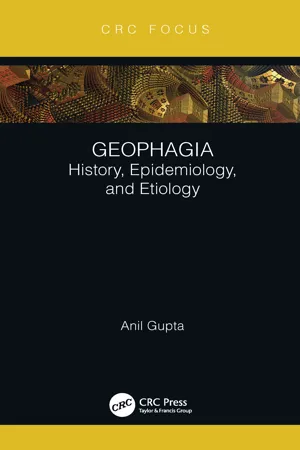1.1 Introduction
Geophagia is an abnormal eating behavior that has been reported among preschool children, pregnant women, mentally challenged individuals, and rarely adults. Astoundingly, the habit has been documented by various authors from ancient periods who substantiate the widespread prevalence of geophagia across different regions of the world. Geophagia has been adjudged a morbid habit in consequence of poverty and starvation, a psychiatric disorder, and an essential practice that is practiced in families and inherited from one generation to another, outside of the culture, religion, and rituals of a society.
Various definitions and conceptual models have been put forward in pursuit of an explanation of the cause-and-effect relationship of geophagia. These conceptual models have academic significance but little interventional role in managing the habit of geophagia. Even though geophagia has universal prevalence among selected regions of developed and developing countries alike, nevertheless, a concrete and collaborative interventional plan against the public health hazard has been completely overlooked. Disparate views have been provided narrating the definition and etiology of geophagia, along with dissimilarity in reporting the types of non-edible items consumed by patients. The ambiguity has resulted in a set of contradictory definitions of geophagia.
1.2 Definitions of Geophagia
•Ziegler (1997) described geophagia as the practice of consuming earth or earthy substances like clay or chalk.
•Danford (1982) described geophagia and pica as the abnormal and intense (pathological) desire for a food substance or non-food substance. In this definition, Danford (1982) included the consumption of both edibles and non-edibles as geophagia, provided the edibles are consumed in an abnormal pattern. The intake of raw rice, excessive ice cubes, and raw potatoes is labeled a pica habit.
•Mosby’s Medical Dictionary (2009) defined geophagia as the habit of eating clay or dirt.
•Ekosse and Junbam (2010) defined geophagia as the practice of involuntary ingestion of soil.
•Hawass et al. (1987) and Ghorbani (2008) described geophagia as the intense compulsion to eat clay or dirt or substances from the lithosphere.
•McLoughlin (1987) labeled geophagia a type of pica.
•Johns and Duquette (1991) posited that geophagia involves the incessant desire to ingest clay.
•Reid (2010) defined geophagia as an idiosyncrasy in a small group of individuals or culturally sanctioned behavior related to dirt eating that is widespread across the world within specific societies.
•According to Taber (1985) and Lacey (1989), geophagia is a perverted appetite with an urge for the intake of materials that are termed non-food items that is practiced by a few women in pregnancy through the ingestion of clay, starch, plaster, or ashes. This condition is observable in hysteria, some psychiatric disorders, and helminthiasis.
•According to Stedman (1982) and Lacey (1989), geophagia is an immoral appetite and is the hunger for materials that are not fit for human consumption.
1.3 Critical Review of Geophagia
In geophagia, individuals consume soil, clay, or chalk. These are non-food substances; according to the definition of “food” (Encyclopedia Britannica 2017), it is a substance that is essentially made up of organic and inorganic components for use by organisms so as to maintain growth, perform repairs, and derive energy.
Eating is a physiological process among heterotrophic organisms to obtain nutrients for survival. Nevertheless, soil, clay, and chalk that are mostly consumed in geophagia are not nutrients. Therefore, eating of non-food items by humans cannot be described as normal eating behavior.
Some authors have described geophagia as a habit (Johns and Duquette 1991; Glickman et al. 1995; Mosby’s Medical Dictionary 2009; Wikipedia 2017). Habit is a regular behavior that is acquired through regular previous practice. Habits are performed subconsciously, as an individual does not require introspection while performing routine behavior. Thus, the etiology of the habit of geophagia lies in the customary practice among certain communities of the world where eating soil or clay becomes an essential cultural practice among pregnant women. This habit passes from one generation to other (Nyaruhucha 2009), while in other tribes, owing to poverty, the habit has been adopted by poverty-stricken people to satiate by consuming soil, clay, or kaolin (Schmidt and Ayer 2009).
Other workers have posited geophagia as a compulsive behavior that is a psychiatric disorder. A compulsive behavior involves an intense urge to perform an activity, unlike a habit, which happens subconsciously (Hawass et al. 1987; Ghorbani 2008; Ekosse and Junbam 2010).
Nonetheless, the American Psychiatric Association considers geophagia a feeding and eating disorder (APA 2013). It is a mental disorder characterized by abnormal eating habits that is detrimental to the health of individuals. Eating disorders are potentially harmful and impair the eating behavior of affected individuals (NIMH 2016).
Geophagia has been reported among women during pregnancy (O’Rourke et al. 1967). It is generally associated with iron-deficiency anemia (Sayers et al. 1974). Geophagia, in the literature, has served to satiate the hunger of people during acute scarcity of foods, as in famine, and could be a substitute for food in poverty (Hawass et al. 1987). Geophagia has been noticed during anorexia nervosa (Woywodt and Kiss 2002).
Geophagia has been reported as a major health problem in individuals who are suffering from congenital cognitive impairment and psychiatric disorders (D’Eredita et al. 1999). Ingestion of non-food substances by mentally challenged people is associated with a prevalence of high morbidity (Ilhan et al...
